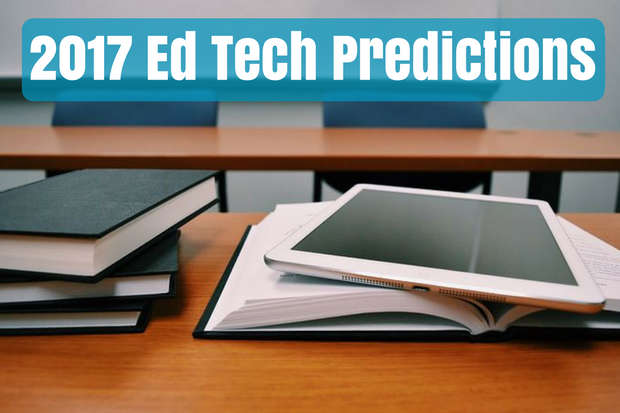5 Ed Tech Predictions for 2017
Written by:
Kajeet

It’s a new year, and with that comes new predictions. So what are educators saying?
In a 2016 survey District Administration asked of 277 K-12 leaders which instructional practice will receive the most attention from their district in 2017.
- Adopting new assessment strategies/techniques--40 percent
- Incorporating new/increased instructional technology--36 percent
- Meeting new learning standards--34 percent
- Personalizing instruction--32 percent
The survey included which areas in regards to technology will see significant growth in 2017.
- Tablets or other portable devices--44 percent
- Internet/Wi-Fi infrastructure--37 percent
- Cloud computing storage--26 percent
- BYOD or one-to-one initiative--22 percent
Reviewing the survey and other sources, we came up with five ed-tech predictions for 2017.
1. Personalized Learning Propels One-to-One
The survey results show an increase in BYOD or one-to-one initiatives. While only 32 percent see a significant growth, teachers who report having a one-to-one device program have increased 10 percentage points from 2015 to 2016. One-to-one programs will steadily grow year-over-year.
Educators will continue to tailor curriculum to the interests and learning styles of students, which is made possible by the increase of one-to-one programs. ISTE describes personalized learning as a combination of face-to-face learning with the teacher in the classroom and technology-assisted instruction. Learning may be tailored to a student’s preference, and the instruction is paced to a student’s unique needs.
Throughout 2017 as personalization increases and portable devices grow in popularity in the classroom, it will be important to ensure students have connectivity at home and remain focused on educational materials outside the classroom through filtered Education Broadband™. Keep students on track while incorporating technology in order to see personalized success.
2. Makerspaces Take Shape
This increase in personalized learning is also driving the switch to active learning. Educators have talked about makerspaces in recent years, but now that talk will turn into action for 2017. Makerspaces provide an active learning environment for students where they can use their creativity and solve problem-based challenges.
In an EdTech interview with Laura Fleming, a library media specialist at a New Jersey school, she explains the importance of makerspaces as “open-ended exploration” opportunities for students. “All good makerspaces put kids first in all that they do,” said Fleming. “The voice of the learner is an essential part in creating a makerspace.”
The makerspace movement provides an environment for student-centered learning and empowerment. In conjunction with makerspaces there will be a rise in coding and programming. “The IT department has been integral; not only have they donated things like their work benches from home and the computers, they have also served as mentors for kids in our space,” said Fleming. “Having my IT department here to support me has been essential in providing the kids the makerspace that they want.”
Students are looking to be actively engaged in classrooms, therefore having makerspaces and a “maker mindset” will help schools prepare students for their future.
3. Online Homework Hand-In
Technology will continue to be integrated into curriculum, including outside the classroom as well. Software systems can monitor when students have turned in their assignments, alerting teachers and helping keep everyone on track. Kelly J. Calhoun, research director at Gartner said, “this way, nothing can fall into the cracks.” Schools that are connected in- and outside the classroom can keep parents informed and students on the same page.
As this trend grows, educators will need to address the growing Homework Gap to help students who don’t have access to Internet outside of the classroom. An 8 p.m. deadline to turn in homework certainly puts students without Internet at a disadvantage if the library closes at 5 p.m. School districts need to consider solutions to ensure all students are on a level playing field in order to reach success.
4. Making Virtual a Reality
Another tech trend for the classroom will be virtual reality (VR). A Samsung infographic asked K-12 teachers how they feel about VR in their classrooms:
- 85 percent of teachers agreed virtual reality would have a positive effect on their students;
- 84 percent think it will increase student motivation;
- And 77 percent said it will help students better understand learning concepts.
While only two percent of teachers currently use VR in their classrooms, incorporating it into the curriculum will increase as this technology becomes readily available. VR aligns with the growth in personalized and active learning by allowing students immersive simulations, while remaining in the classroom. This is a trend educators will continue to see in 2017 and beyond.
5. Internet of Teachers? The Growth of Internet of Things (IoT)
Even though the IoT may not see significant growth in education this year, schools will be progressing toward an age of IoT. As mentioned above, 37 percent of educators predict significant growth for Internet and Wi-Fi infrastructure. Eventually, everything in school – including lights and thermostats – will be controllable by servers. The District Administration article explains how the data will be transferred via Wi-Fi. However, “each device has to be secured and encrypted as if it were a desktop PC or tablet,” said Gartner’s Calhoun.
While we may not see a surge in IoT in schools this year, technology is rapidly changing the education landscape. See what produces strong results with your students, and communicate with other educators about what’s working for them. Whichever trend you see, it’s important to focus on the end goal of success for every student.

